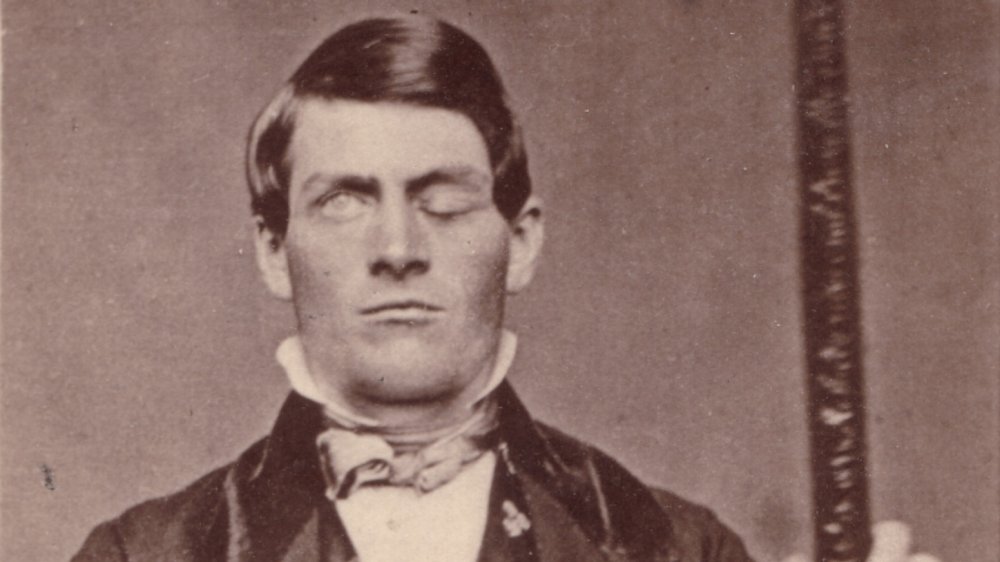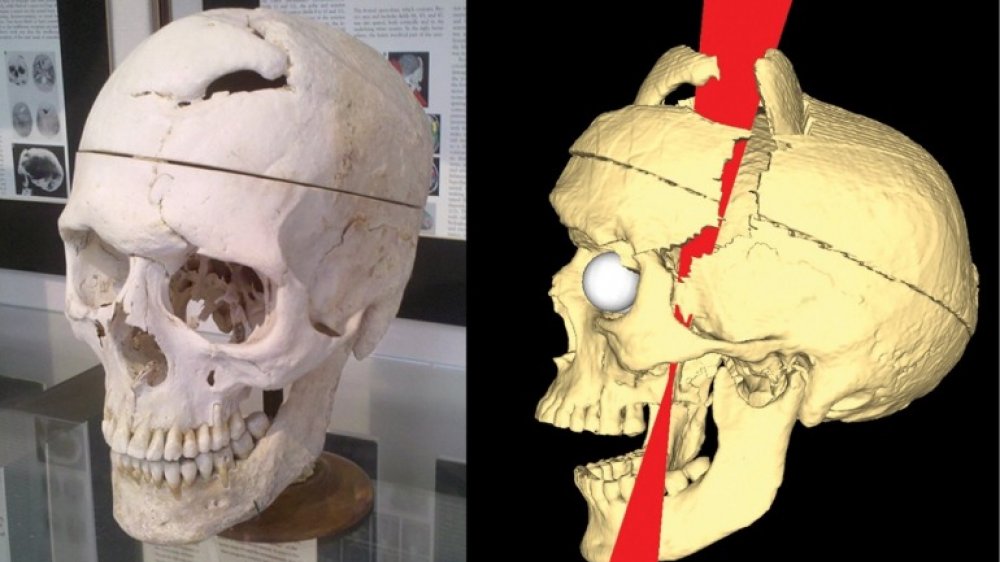The Untold Truth Of Phineas Gage
Phineas Gage has been called "neuroscience's most famous patient." On September 14, 1848, the railroad foreman suffered a grusome accident that seems completely impossible to survive. As Sam Kean wrote for Slate in 2014, Gage and his crew were working near Cavendish, Vermont. He became momentarily distracted while tamping gunpowder down into a hole using a specially commissioned rod weighing a little over 13 pounds and a little over 43 inches long. The rod was about an inch-and-a-quarter in diameter, "although the last foot — the part Gage held near his head when tamping — tapered to a point." The tamping process produced a spark that ignited the gunpowder and sent the rod "rocketing" into Gage's face. It entered below his left cheekbone, destroyed a molar, slid behind his left eye, through "the underbelly of his brain's left frontal lobe," and through his skull, exiting out of the top of his head.
Gage apparently didn't even pass out in the course of this horrifying accident; he actually climbed into an oxcart and sat upright as he was driven to a doctor, whom he greeted by quipping, "Here's business enough for you," with "a volcano of upturned bone jutting out of [his] scalp." According to Slate, Gage survived the operation but nearly died during recovery, as "His face puffed up, his brain swelled, and he started raving, at one point demanding that someone find his pants so he could go outside." A fungal infection resulted, followed by a coma.
'Quite recovered in his faculties of body and mind'
Doctors treated his complications, and after several "touch and go" weeks, Gage recovered enough to return to his home in Lebanon, New Hampshire. He had lost sight in his left eye; it remained sewn shut for the rest of his life. Amazingly, he kept the notorious rod and carried it around with him until his death in 1860.
According to Slate, the press immediately jumped on Gage's story, giving it "the tabloid treatment, emphasizing the sheer improbability of his survival." Dr. Henry Bigelow brought him to Harvard Medical School for evaluation in 1849, where he was pronounced "quite recovered in his faculties of body and mind." As Kean points out, however, the exam probably wasn't all that thorough — "Bigelow probably only tested Gage for sensory and motor deficits." Gage's brain was injured in its front lobe, which at the time was thought to be a less important part of the brain; scientists now know that this area, particularly the prefrontal lobe, "plays an especially important role in impulse control and planning." Gage went on to travel to South America in 1852, "recruited by an entrepreneur hoping to take advantage of a gold rush in Chile." He stayed on for several years, working as a stagecoach driver, until he joined family in San Francisco for the rest of his days.
Gage 'was no longer Gage'
One of the doctors who had performed Gage's life-saving operation, John Harlow, wrote up a full case report, the only source of information about Gage outside of the Harvard Medical School evaluation. Harlow discussed several personality changes in Gage, concluding, "the equilibrium ... between his intellectual faculties and his animal propensities seems to have been destroyed" and famously quoting one of Gage's friends, who said that Gage, post-accident, "was no longer Gage." Wild stories about Gage proliferated for decades; per Slate: "Some sources describe Gage as sexually apathetic, others as promiscuous; some as hot-tempered, others as emotionally void, as if lobotomized ... In another tale ... Gage lived for 20 years with the iron rod still impaled in his skull."
Slate discussed this with Gage scholar Malcolm Macmillan, who pointed out, "When you look at the stories told about Phineas, you get the impression that [scientists] are indulging in something like poetic license — to make the story more vivid, to make it fit in with their preconceptions." Macmillan notes that the fact that Gage spent years driving stagecoaches contradicts reports of his "impulsive behavior, uncontrolled behavior." Macmillan posits "that Gage's behavioral troubles were temporary and that Gage eventually recovered some of his lost mental functions." He further summarizes: "Phineas's story is worth remembering because it illustrates how easily a small stock of facts can be transformed into popular and scientific myth."


